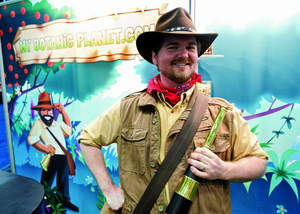MISSION, KS--(Marketwire - Aug 15, 2011) - (Family Features) Whether you're a parent, a classroom teacher, or a homeschool instructor, you know that students learn best when they can interact with their subject. It can be fun and inspirational to explore and experience an educational concept first hand.
The sample project featured here comes from a new, free resource that's helping to inspire an appreciation of botany in elementary-aged students across the country. The educator website www.MyBotanicPlanet.com is a creative collaboration between TruGreen, the nation's largest professional lawn, tree and shrub care service provider, and the Memphis Botanic Garden.
U.S. standardized lesson plans in botany and related activities available on www.MyBotanicPlanet.com were created by professional curriculum developers to help grades K-5 teachers and students explore the diverse plant world. Through online and hands-on experiences, this creative educator resource lets students customize an avatar to explore colorful plant environments and interactive games as they learn. My Botanic Planet visitors can interact with educational guides Flavor Flores on an adventure in the origin of plant flavors, and with Inspector Nectar on a flower mystery investigation.
My Botanic Planet
Flower Investigation
There's no better way for students to investigate the parts of a flower than by dissecting real ones.
What you need
- Enough real flowers for pairs or groups to work together. Alstroemerias and gladiolus work well and are available year round in supermarket floral departments. Azaleas or any member of the lily family could also be used because the parts are well-defined and easy to see.
- Plastic knives and tweezers could be used for dissecting equipment.
- A magnifying glass would allow for closer inspection.
Getting started
- Open up the flower. This is easily done by first locating the base of the flower and slicing or splitting it in half. Use a dissection tool or even a fingernail.
- Next, slice or pinch off the petals. Remind students to be careful with all of the tiny pieces. It's easy to damage or brush away some of the most important parts.
Review the parts of the flower
- Petal: This is the colorful part of the flower that attracts the attention of birds, bees and butterflies, letting them know that there is food inside the flower. Have students record how many petals their flower has and what they look like.
- Stamen: This is where the pollen is made. For older students, you could also point out that the top part that holds the pollen is the anther and the stem part is called the filament. Students should record how many stamens their flower has. If it has six petals, it will also have six stamens. If they have an extra piece, then one should look a little bit different, and is actually part of the pistil.
- Pistil: This is where the seeds are made. The pistil is made of three different parts. The very top of the pistil is called the stigma. The stigma is where the pollen falls when a pollinator brings it in. The pollen travels down the tube (style) and goes down to the bottom (ovary) where the seeds will form. Split the pistil lengthwise to look inside. You should see unfertilized beginnings of seeds. The seed pattern inside will be the same pattern of seeds within the fruit later. If you cut an apple in half horizontally and see the five seeds in a star pattern, you will know that the flower's pistil had five compartments.
- Sepal: These are the tiny leaves on the lower part of the flower that protect it before it begins to bloom. Every flowering bud is hidden safely behind these two little leaves until the flower is fully developed. When the bloom begins to grow, the sepal will split open and the petals can break out.
Next steps
For Grades K-2
- Fold a piece of paper in half twice, creating four smaller panels. Go on a school discovery where kids draw pictures of various flowering plants. Have kids take home papers and draw flowers they see at home or in their neighborhood. Collect all of the images and sort the flowers according to color, type, where they were seen, etc. Then create a "Students in Bloom" bulletin board where the pictures are showcased.
For Grades 3-5
- Pollinator Power: Ask students to research a specific pollinator, such as bees, butterflies or moths, and find out where they live, how much nectar they eat, how many plants they visit in a day, etc., and report back to the class. For example, hummingbirds can visit up to 1,500 flowers a day and consume almost twice their body weight in nectar daily.
Extension lesson
Every fruit began as a flower. In an apple, for example, the petals withered away and the ovary grew containing the seeds, but there are other parts still there, like the sepal and flower stem. Bring in various fruits to "dissect" and examine the seeds and other parts. Chart their similarities and differences.
Visit TruGreen's www.MyBotanicPlanet.com with your student to explore some of the flowers in our environment. The website reinforces concepts featured in this sample activity in botany with an interactive glossary and games.
About Family Features Editorial Syndicate
This and other food and lifestyle content can be found at www.editors.familyfeatures.com. Family Features is a leading provider of free food and lifestyle content for use in print and online publications. Register with no obligation to access a variety of formatted and unformatted features, accompanying photos, and automatically updating Web content solutions.
Contact Information:
Wendy MacDonald
wmacdonald@familyfeatures.com
1-888-824-3337 ext. 235
http://editors.familyfeatures.com
